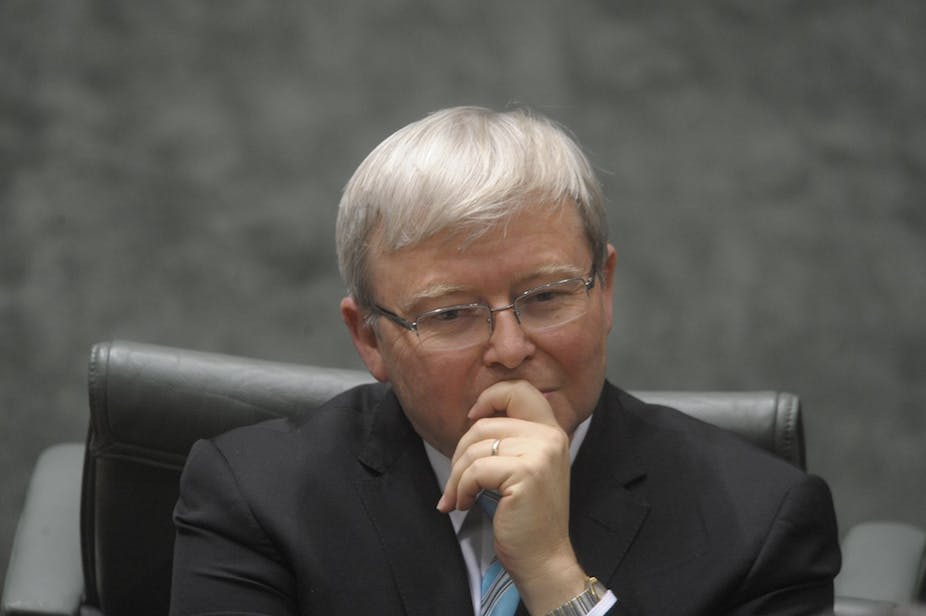The relationship between the former Gillard government and business reached a very low point when last March, a peak business body complained that the business community was being treated with “a complete lack of respect”. The change in leadership offers an opportunity for the Labor party to mend this relationship.
It is difficult to point out a particular reason or event that caused the deterioration in the relationship between the previous government of Julia Gillard and the business community.
Such deterioration might even be surprising for some given that a commitment to “fixing” the mining tax — as a result of a very effective campaign by the mining companies — and not to introduce a carbon tax were an important part of the narrative surrounding the replacement of Kevin Rudd as prime minister in June 2010 and the subsequent election campaign.
However, there are two key sources of business discontentment. First, the lack of competitiveness as a nation; many businesses cannot compete with imports and exporters are finding it harder to compete internationally and some blame the government for that. Second, a perception, rightly or wrongly, that the government changes policy direction with the news cycle and legislation is rushed through parliament.
This diagnosis is important because it sets the broad parameters for defining what actions our new PM can take to repair the relationship with business. The issue of policy reversals and rushed legislation is complex and goes considerably beyond economics. Therefore, I will instead focus on our lack of competitiveness, its relationship with recent policies and what Kevin Rudd can do about it to improve the relationship with business.
Improve our competitiveness
The lack of competitiveness is by and large, but not exclusively, a result of the high Australian dollar caused by the mining boom. Regardless of who wins the election, our economic institutions (for example, floating exchange rate, independent central bank, and low tariffs) will likely result in the Aussie dollar making its way towards long-term purchasing power parity, and considerably below parity with the US dollar.
However, some of our lack of competitiveness is self-imposed and not driven by the vagaries of the global economy. This includes the increased burden of regulation and red tape, a phenomenon spanning different governments, and a cumbersome Industrial Relations system. Recognition by our PM that red tape has increased under the watch of Labor governments and a commitment to reducing it will offer at least a symbolic gesture that can contribute to a more positive attitude towards government by businesses.
Address industrial relations concerns
Industrial relations reform requires a more sophisticated discussion around two issues. First, if voters think that the current level of protection afforded to workers by the existing regime is appropriate, then the PM can at least ask the question of whether the same level of protection can be achieved by a simpler and less costly system.
Despite some existing rhetoric, real unit labour costs (non-farm) are lower now than when the Coalition lost the 2007 election. In fact, real unit labour costs fell steadily between 1985 and 2010, and have remained broadly stable since then. This means that it may be possible that a more efficient industrial relations system can lead to a better allocation of resources and lower business costs while maintaining real wages at current levels.
The second issue, more thorny for both Labor and the Coalition, is whether the existing level of protection is too high and increased competitiveness needs to be achieved at the cost of a further decline in real unit labour costs.
Framing industrial relations reform along these lines will allow the PM to ask the genuine question of whether our current industrial relations system can be improved without affecting the level of protection to workers, and this ought to appeal to businesses. This might also force the Coalition to more clearly articulate how they view these two interrelated issues, which would also be welcomed by businesses.
Bring about tax reform
The lack of competitiveness can also be associated with our inability to reform our tax system. While the Henry Review favoured a reduction in the company tax rate, other, more ambitious reforms have also been canvassed but discarded. Chiefly amongst these reforms was the introduction of an Allowance for Corporate Equity (ACE), which would have enabled firms to deduct an imputed return on equity.
By construction, an ACE eliminates the taxation of normal returns on equity, while still taxing economic rents. A normal return is the investor’s opportunity cost of capital. Economic rents are returns in excess of the normal return and are usually either firm or location-specific.
The former emerge, for example, because of a particular technology, know-how, or entrepreneurship skills. The latter are associated with the business’ location in Australia, such as in the case of mineral resources or oligopolistic industries. While tax reform is a long and hard road — just remember how long it took to introduce the GST — the new PM can signal Labor’s commitment to fundamental tax reform and articulate more precisely how tax reform can address the competitiveness challenge.
Regardless of whether Labor wins or loses the election, its relationship with business needs mending. This does not mean that Labor has to “do what business wants”. As I have indicated elsewhere, there is no coherent view from business on how best to address the significant challenges we face as a nation. Instead, the new PM has an opportunity to provide a more coherent narrative, which has been lacking over the last three years, of how if re-elected he intends to address our lack of competitiveness.

